The Seasonal Correlation Between El Niño and Southern Oscillation Events and Sea Surface Temperature Anomalies in the South China Sea from 1958 to 2024
Abstract
1. Introduction
2. Data and Methods
2.1. Data Sources
2.2. Methods
3. Result
3.1. Seasonal Variation in SSTAs in South China Sea
3.2. Analysis of SSTA Assemblages in South China Sea During Strong ENSO Events from 1958 to 2021
3.3. Correlation Analysis of Relevant Elements
- Clouds: Clouds cause friction and reduce wind speed, which, in turn, affects the generation and distribution of shear kinetic energy by limiting vertical mixing of the atmosphere and altering boundary layer dynamics.
- Atmospheric Heating through surface heat flow enhances upward air movement, reduces air density, and accelerates air. An increase in airflow velocity results in an increase in shear energy by amplifying wind shear between atmospheric layers [35].
- Evaporation: Evaporation cools the ocean surface, increases air density, and reduces wind speed in the lower atmosphere. However, this process also increases moisture in the air, potentially enhancing convection and altering wind patterns, which can affect shear energy.
- Precipitation: Precipitation has a dual effect on shear energy. On one hand, it provides resistance to atmospheric flow and reduces wind speed. On the other hand, it is associated with strong convective systems, which can increase wind shear under certain conditions, depending on the specific dynamics of the precipitation event.
4. Conclusions
Author Contributions
Funding
Institutional Review Board Statement
Informed Consent Statement
Data Availability Statement
Acknowledgments
Conflicts of Interest
References
- Frequency of Different Types of El Niño Events Under Global Warming—Alizadeh—2022—International Journal of Climatology—Wiley Online Library. Available online: https://rmets.onlinelibrary.wiley.com/doi/10.1002/joc.7858 (accessed on 10 December 2024).
- Enochs, I.C.; Glynn, P.W.; Manzello, D.P. (Eds.) Coral Reefs of the Eastern Tropical Pacific: Persistence and Loss in a Dynamic Environment, 1st ed.; Coral Reefs of the, World; Springer: Dordrecht, The Netherlands; Imprint: Dordrecht, The Netherlands, 2017; ISBN 978-94-017-7499-4. [Google Scholar]
- Alizadeh, O. A Review of ENSO Teleconnections at Present and under Future Global Warming. WIREs Clim. Change 2024, 15, e861. [Google Scholar] [CrossRef]
- On the Decadal Changes of the Interannual Relationship Between ENSO and Tropical South Atlantic SST in Boreal Summer—Yang—2023—Geophysical Research Letters—Wiley Online Library. Available online: https://agupubs.onlinelibrary.wiley.com/doi/10.1029/2023GL104355 (accessed on 10 December 2024).
- Asymmetric Relationship between ENSO and the Tropical Indian Ocean Summer SST Anomalies in: Journal of Climate Volume 34 Issue 14 (2021). Available online: https://journals.ametsoc.org/view/journals/clim/34/14/JCLI-D-20-0546.1.xml (accessed on 10 December 2024).
- Yan, X.; Ren, J.; Ju, J.; Yang, S. Influence of Springtime Atlantic SST on ENSO: Role of the Madden–Julian Oscillation. Meteorol. J. 2018, 32, 380–393. [Google Scholar] [CrossRef]
- Lanzante, J.R. Lag Relationships Involving Tropical Sea Surface Temperatures. J. Clim. 1902, 9, 2568–2578. [Google Scholar] [CrossRef]
- Fei, Y.; Yi, X. Study of Long-Term Variational Trend of Sea Surface Temperature in the East China Sea. Adv. Mar. Sci. 2003, 21, 477–481. [Google Scholar] [CrossRef]
- Li, C.; Mu, M. El Niño Occurrence and Sub-Struface Ocean Temperature Anomalies in the Pacific Warm Pool. Chin. J. Atmos. Sci.-Chin. Ed. 2011, 23, 513–521. [Google Scholar] [CrossRef]
- Chao, Q.C.; Chao, J.P. Climatic Trends and Extremes of Tropical Cyclone Precipitation Affecting China and Its Key Economic Zones. Chin. J. Atmos. Sci. 2014, 38, 1029–1040. [Google Scholar] [CrossRef]
- Lin, T. Interdecadal variability of the relationship between ENSO and SST over the South China Sea. J. Mar. Meteorol. 2019, 39, 68–75. [Google Scholar] [CrossRef]
- Wu, G.X.; Meng, W. Gearing between the Indo-monsoon Circulation and the Pacific-Walker Circulation and the ENSO. Part I:_Data Analyses. CJAS 2011, 22, 470–480. [Google Scholar] [CrossRef]
- A Review of the El Niño-Southern Oscillation in Future—ScienceDirect. Available online: https://www.sciencedirect.com/science/article/abs/pii/S0012825222003300?via%3Dihub (accessed on 10 December 2024).
- Atlantic Warming Enhances the Influence of Atlantic Niño on ENSO—Wang—2024—Geophysical Research Letters—Wiley Online Library. Available online: https://agupubs.onlinelibrary.wiley.com/doi/10.1029/2023GL108013 (accessed on 10 December 2024).
- Hong, C.; Cho, K.-D.; Kim, H.-J. The Relationship between ENSO Events and Sea Surface Temperature in the East (Japan) Sea. Prog. Oceanogr. 2001, 49, 21–40. [Google Scholar] [CrossRef]
- Yu, S.; Zhou, F.; Fu, G.; Wang, D. Basic Characteristics of Low Frequency Oscillation of Surface Water Temperature in the South China Sea. Ocean Lakes 1994, 5. Available online: https://www.cnki.com.cn/Article/CJFDTotal-HYFZ199405012.htm (accessed on 11 December 2024).
- Diverse Impacts of ENSO on the Intensity of Tropical Western North Pacific Synoptic-Scale Disturbances During Boreal Summer—Gu—2023—Journal of Geophysical Research: Atmospheres—Wiley Online Library. Available online: https://agupubs.onlinelibrary.wiley.com/doi/10.1029/2023JD039238 (accessed on 10 December 2024).
- Yang, J.; Zhao, Y.; Wei, H.; Liu, S.; Zhang, G.; Long, H.; Li, S.; Xu, J. Holocene Sea Surface Temperature and Salinity Variations in the Central South China Sea. Mar. Micropaleontol. 2023, 181, 102229. [Google Scholar] [CrossRef]
- Expansion of Winter ENSO-Associated Rainfall Affected Area in Southeast Asia under Warmer Climate—Leong—2024—International Journal of Climatology—Wiley Online Library. Available online: https://rmets.onlinelibrary.wiley.com/doi/10.1002/joc.8358 (accessed on 10 December 2024).
- Diaz, H.F.; Kiladis, G.N. Atmospheric Teleconnections Associated with the Extreme Phase of the Southern Oscillation. In El Nino Historical & Paleoclimatic Aspects of the Southern Oscillation; Cambridge University Press: Cambridge, UK, 1992. [Google Scholar]
- The Teleconnection of El Niño Southern Oscillation to the Stratosphere—Domeisen—2019—Reviews of Geophysics—Wiley Online Library. Available online: https://agupubs.onlinelibrary.wiley.com/doi/10.1029/2018RG000596 (accessed on 10 December 2024).
- Wu, C.R.; Chang, C.W.J. Interannual Variability of the South China Sea in a Data Assimilation Model. Geophys. Res. Lett. 2005, 321. [Google Scholar] [CrossRef]
- Wang, C.; Wang, W.; Wang, D.; Wang, Q. Interannual Variability of the South China Sea Associated with El Niño. J. Geophys. Res. Atmos. 2006, 111. [Google Scholar] [CrossRef]
- Klein, S.A.; Soden, B.J.; Lau, N.C. Remote Sea Surface Temperature Variations during ENSO: Evidence for a Tropical Atmospheric Bridge. J. Clim. 1999, 12, 917–932. [Google Scholar] [CrossRef]
- Liu, Y.; Deng, Y. Sea Surface Temperature, Land Surface Temperature and the Summer Rainfall Anomalies over Eastern China. Clim. Environ. Res. 2002, 35, 10–14. [Google Scholar] [CrossRef]
- Zhang, P.; Xu, F. Spatial and Temporal Characteristics of the SSTA in the South China Sea from 1979 to 2017 and Its Correlation with the Walker Circulationn Anomaly. J. Mar. Meteorol. 2019, 39, 15–25. [Google Scholar] [CrossRef]
- Alizadeh, O. Amplitude, Duration, Variability, and Seasonal Frequency Analysis of the El Niño-Southern Oscillation. Clim. Change 2022, 174, 20. [Google Scholar] [CrossRef]
- Alizadeh-Choobari, O. Contrasting Global Teleconnection Features of the Eastern Pacific and Central Pacific El Niño Events. Dyn. Atmos. Oceans 2017, 80, 139–154. [Google Scholar] [CrossRef]
- Lian, T.; Wang, J.; Chen, D.; Liu, T.; Wang, D. A Strong 2023/24 El Niño Is Staged by Tropical Pacific Ocean Heat Content Buildup. Ocean-Land-Atmos. Res. 2023, 2, 11. [Google Scholar] [CrossRef]
- Wen, C.; Graf, H.F. The Interannual Variability of East Asian Winter Monsoon and Its Relation to the Summer Monsoon. Adv. Atmos. Sci. 2000, 17, 48–60. [Google Scholar] [CrossRef]
- Alizadeh-Choobari, O.; Adibi, P. Impacts of Large-Scale Teleconnections on Climate Variability over Southwest Asia. Dyn. Atmos. Oceans 2019, 86, 41–51. [Google Scholar] [CrossRef]
- Yang, X.; Huang, P. Restored Relationship between ENSO and Indian Summer Monsoon Rainfall around 1999/2000. Innovation 2021, 2, 100102. [Google Scholar] [CrossRef] [PubMed]
- Zhi, R.; Zheng, Z.; Feng, Q.G. Causes of Positive Precipitation Anomalies in South China during La Niña Winters. Clim. Dyn. Obs. Theor. Comput. Res. Clim. Syst. 2023, 61, 3343–3352. [Google Scholar] [CrossRef]
- Interpreting the Nonstationary Relationship Between El Niño–Southern Oscillation and the Winter Precipitation over Southeast China—Tang—2022—International Journal of Climatology—Wiley Online Library. Available online: https://rmets.onlinelibrary.wiley.com/doi/10.1002/joc.7570 (accessed on 10 December 2024).
- Niu, Z. Long-Period Variation of Surface Water Temperature in the South China Sea and Its Coupling with El Niño, Ocean University of China. Acta Oceanol. Sin. 1994, 16, 43–49. [Google Scholar]
- Li, J.; Huang, D.; Li, F.; Wen, Z. Circulation Characteristics of EP and CP ENSO and Their Impacts on Precipitation in South China. J. Atmos. Sol.-Terr. Phys. 2018, 179, 405–415. [Google Scholar] [CrossRef]
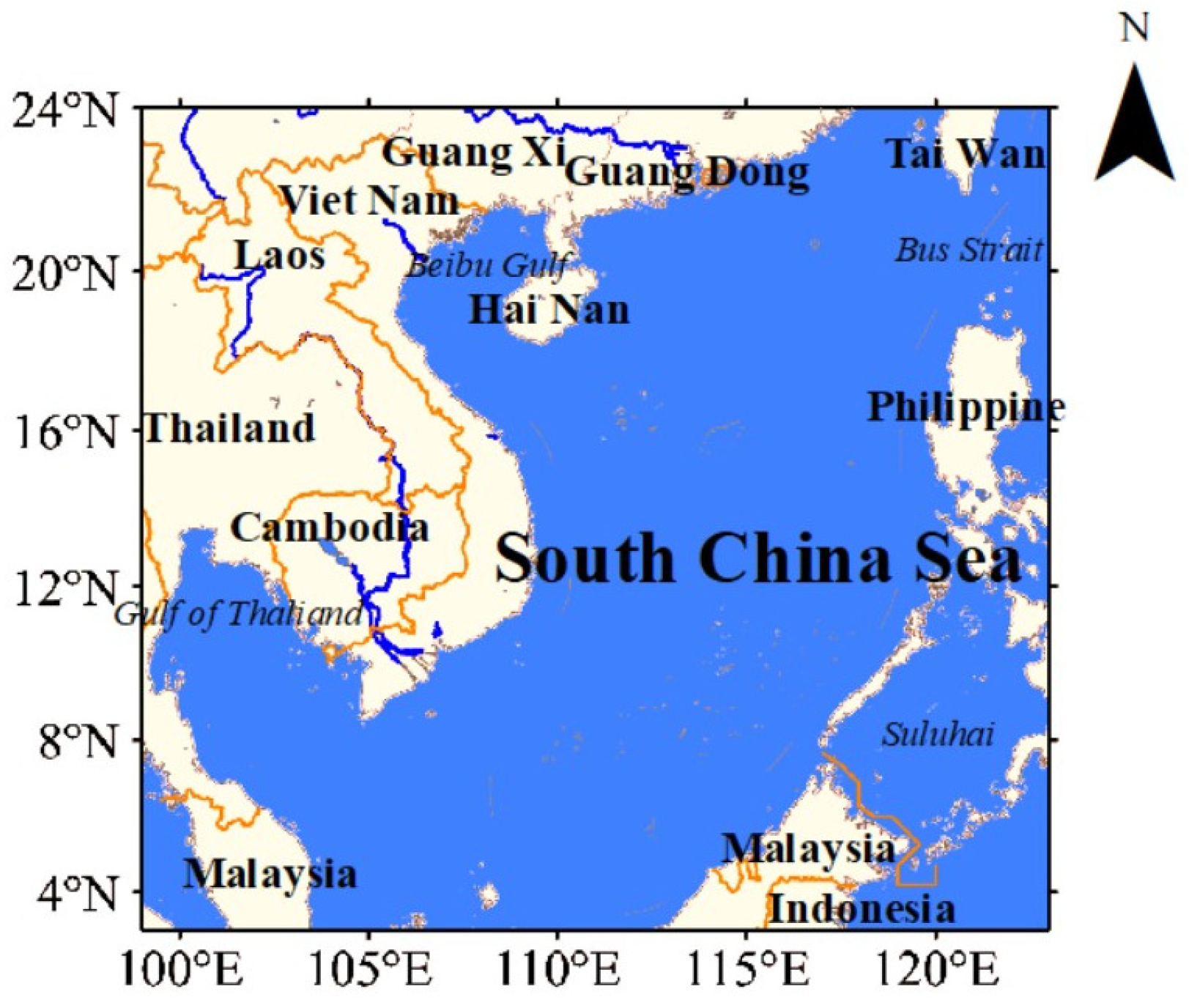
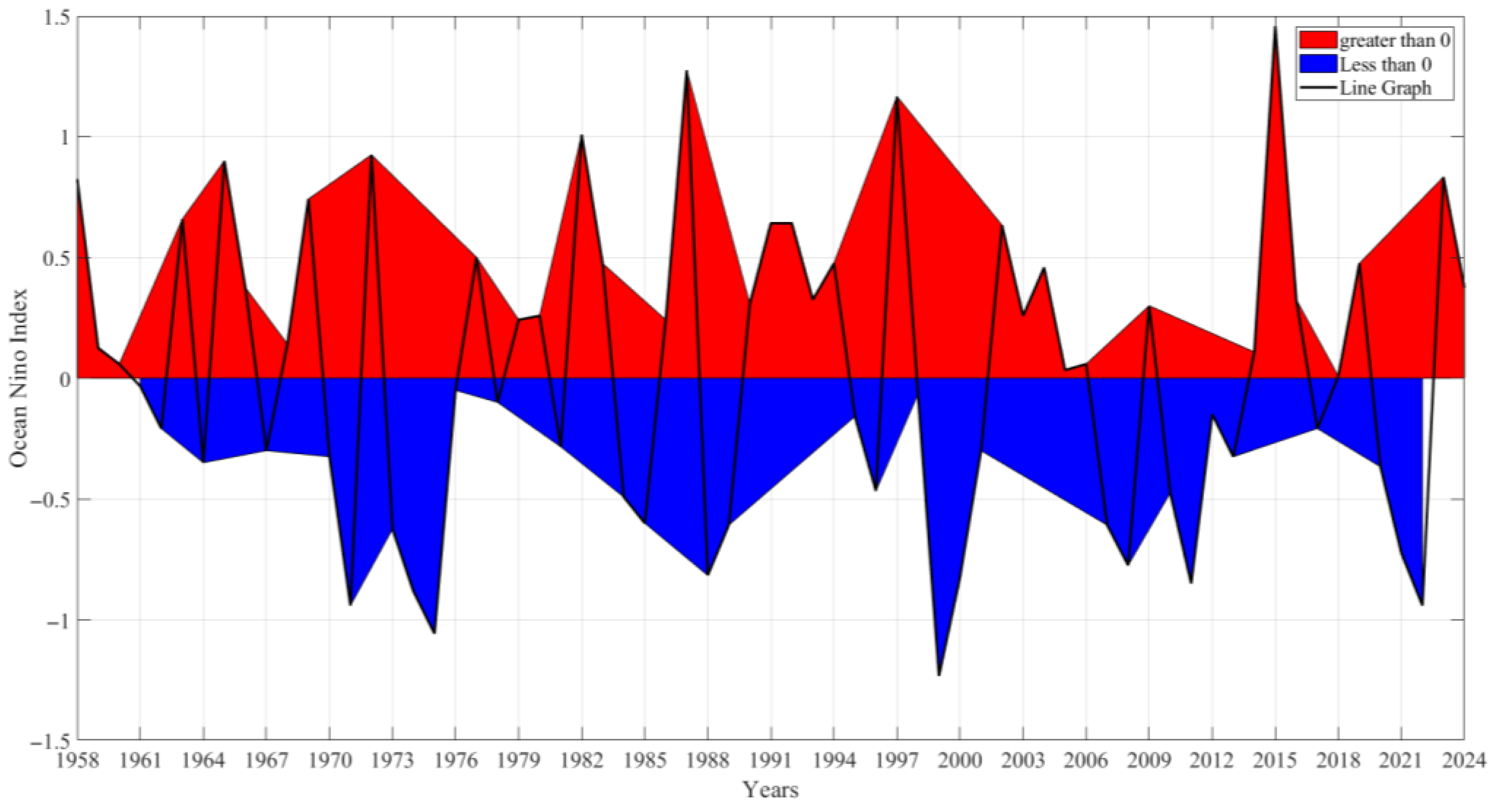

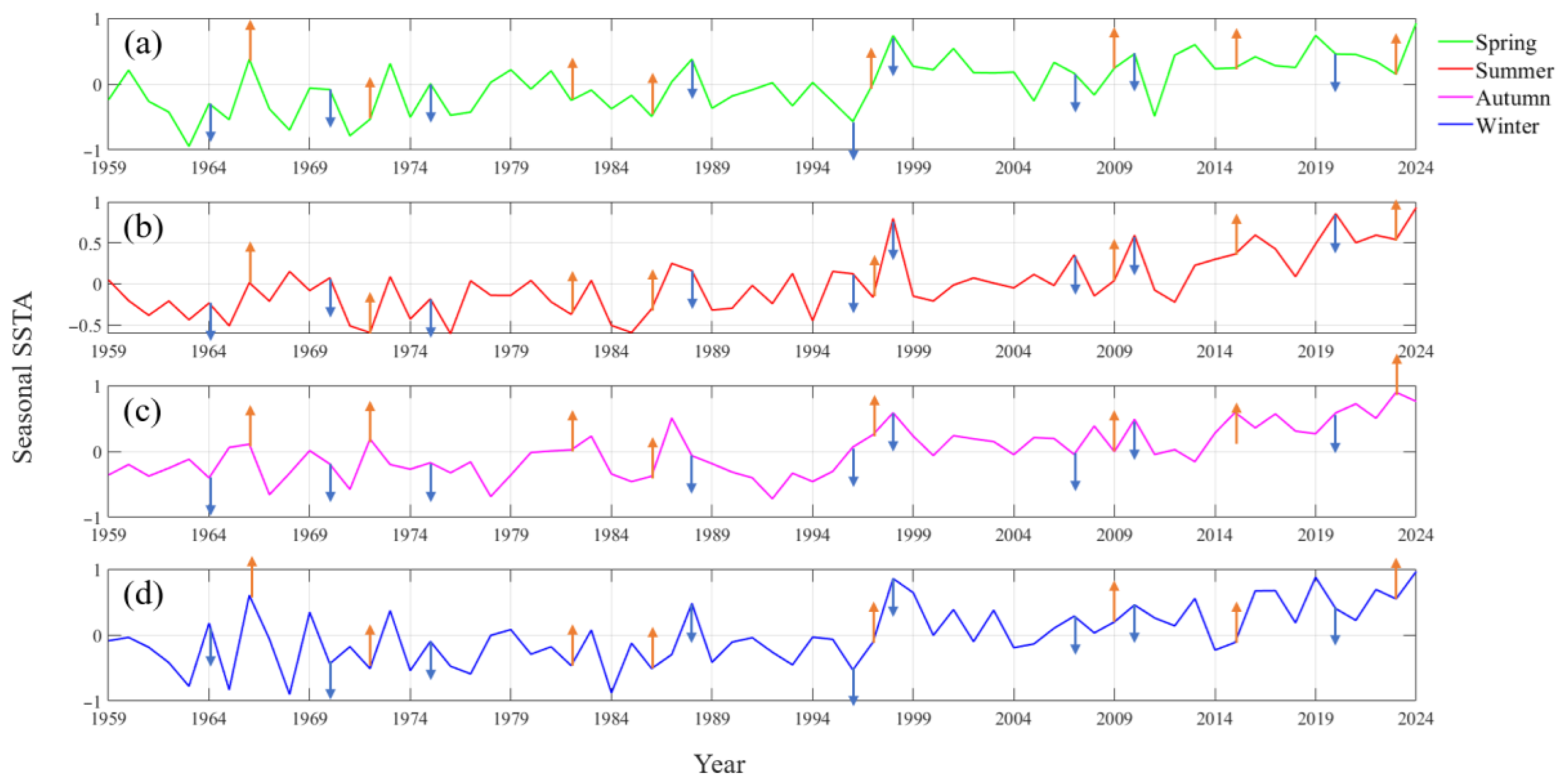
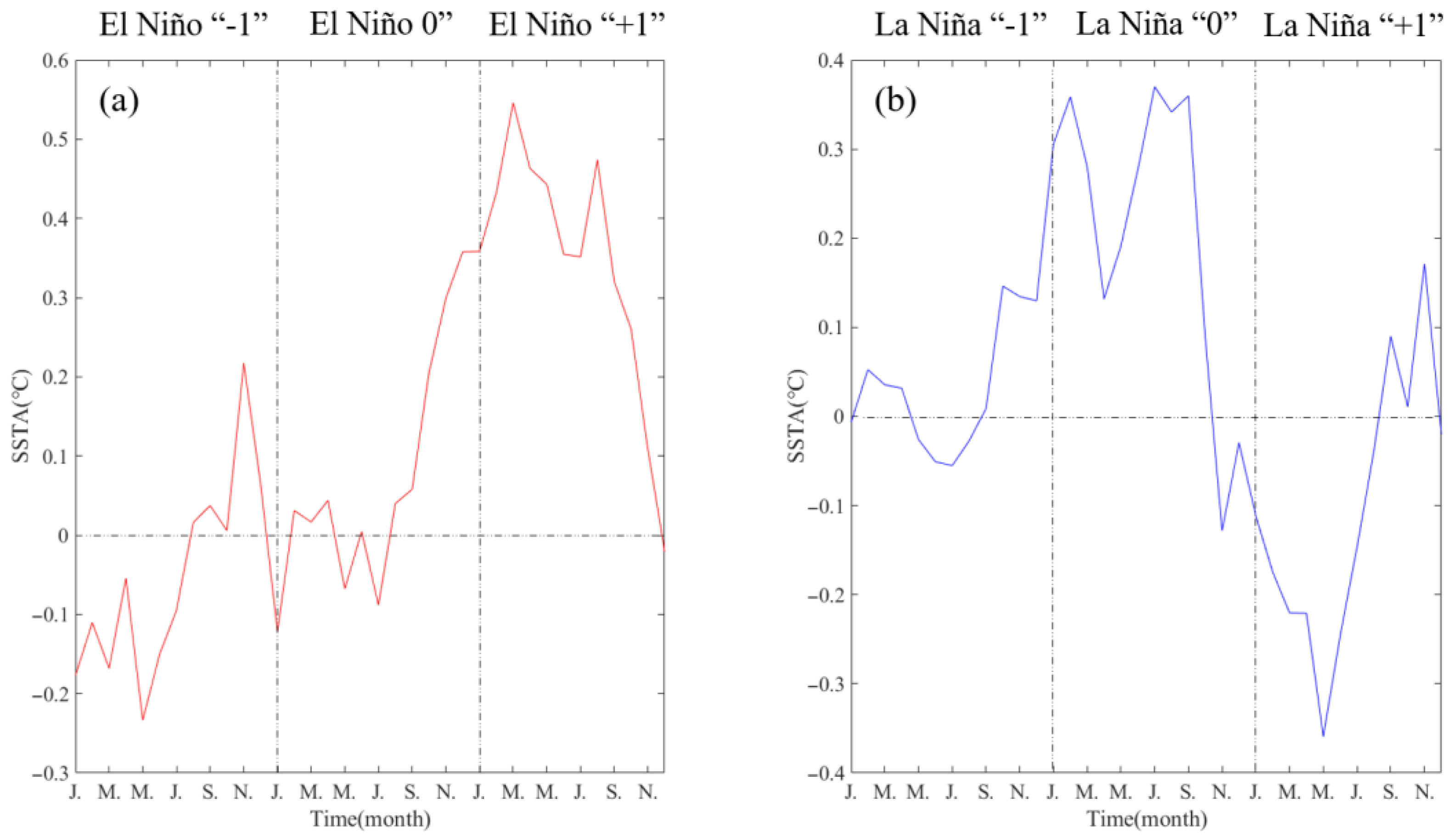
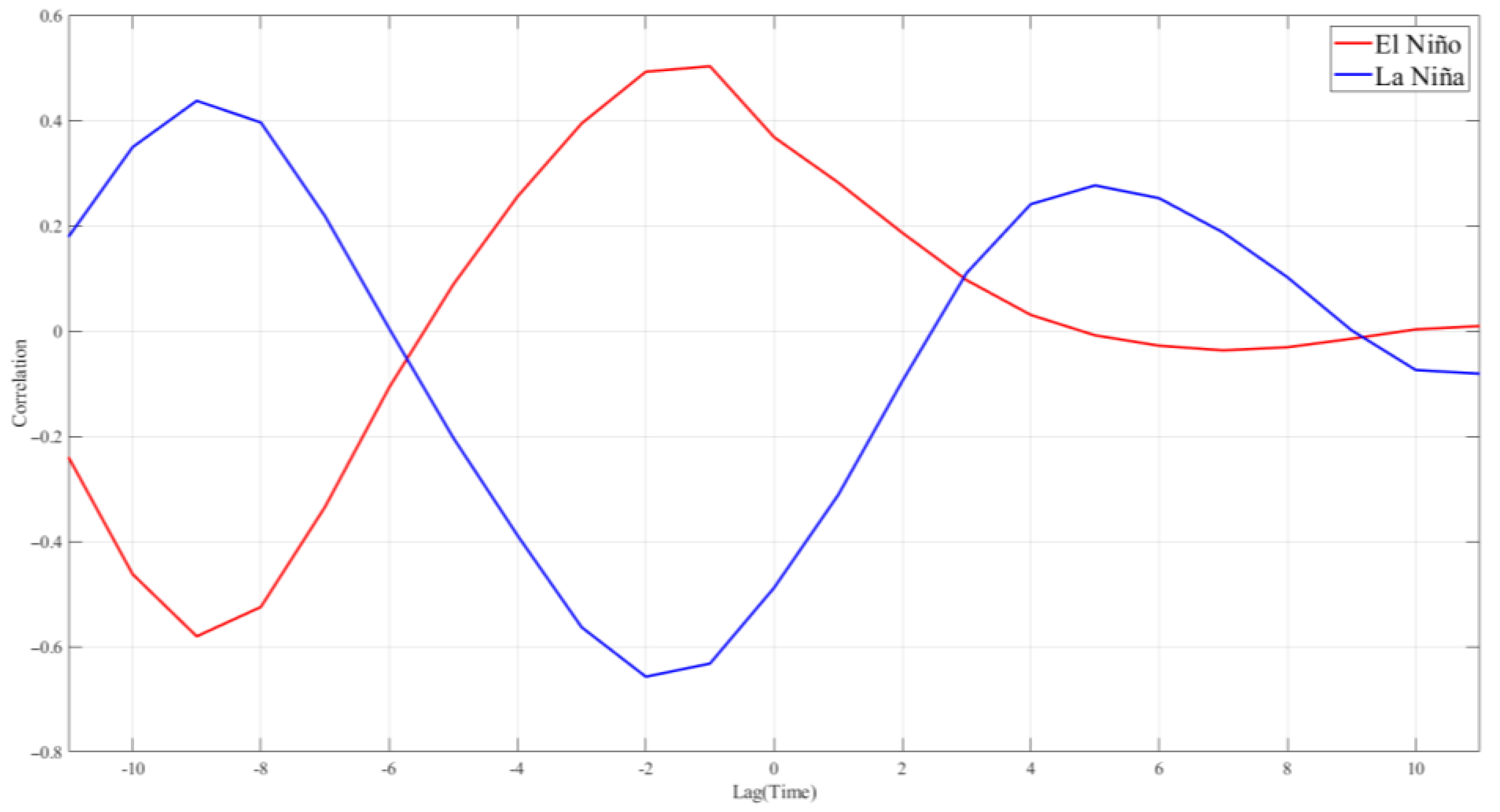


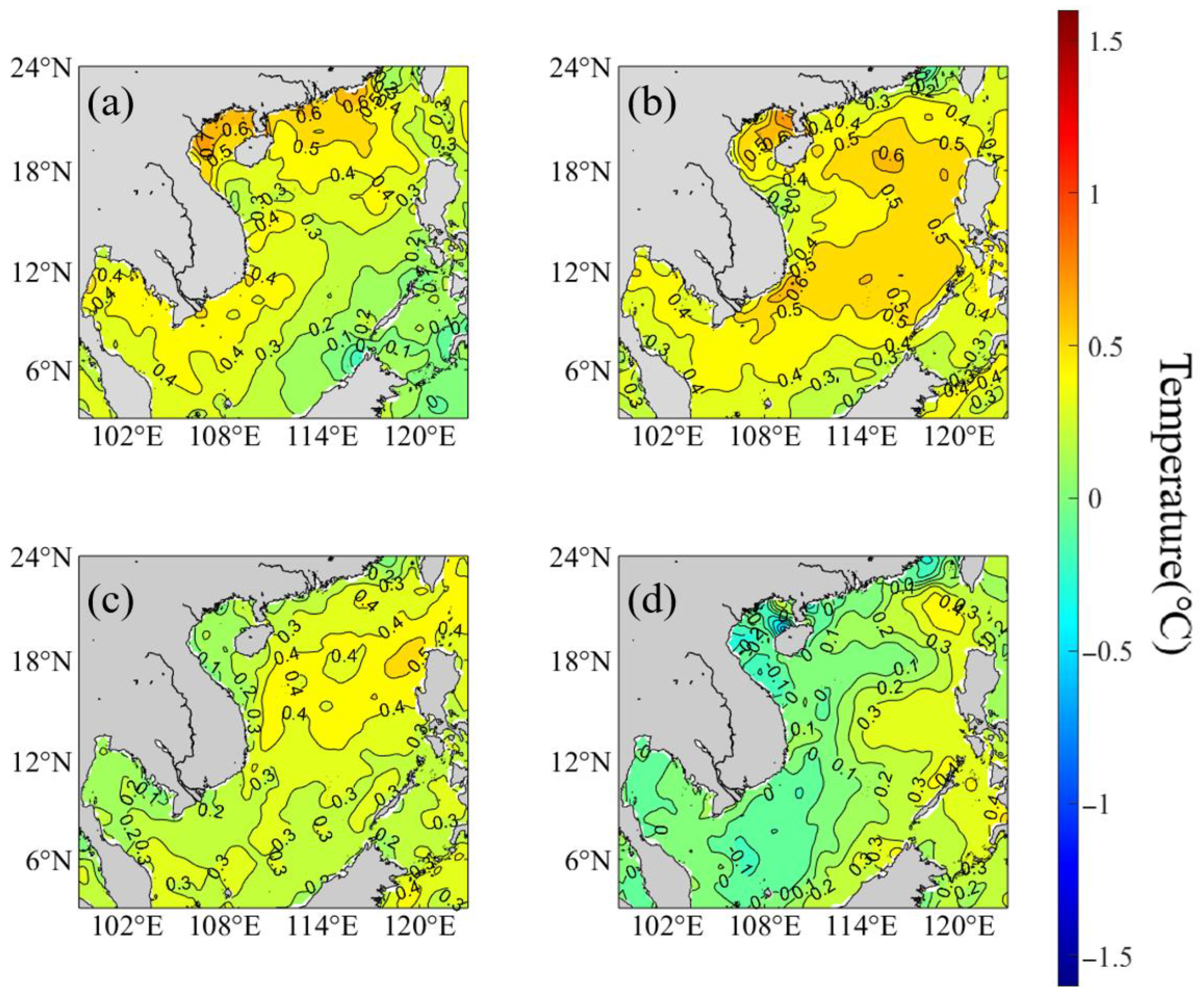
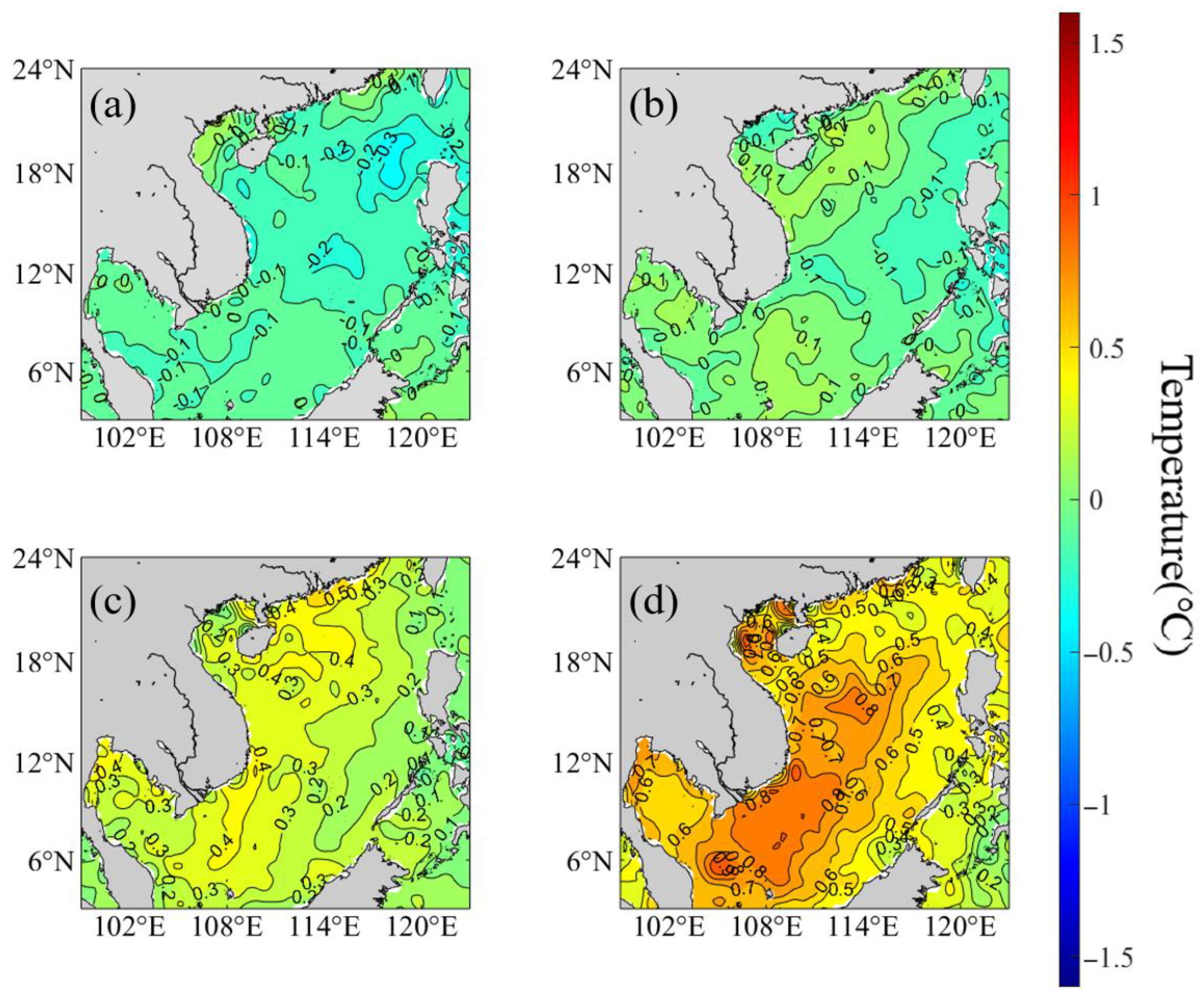
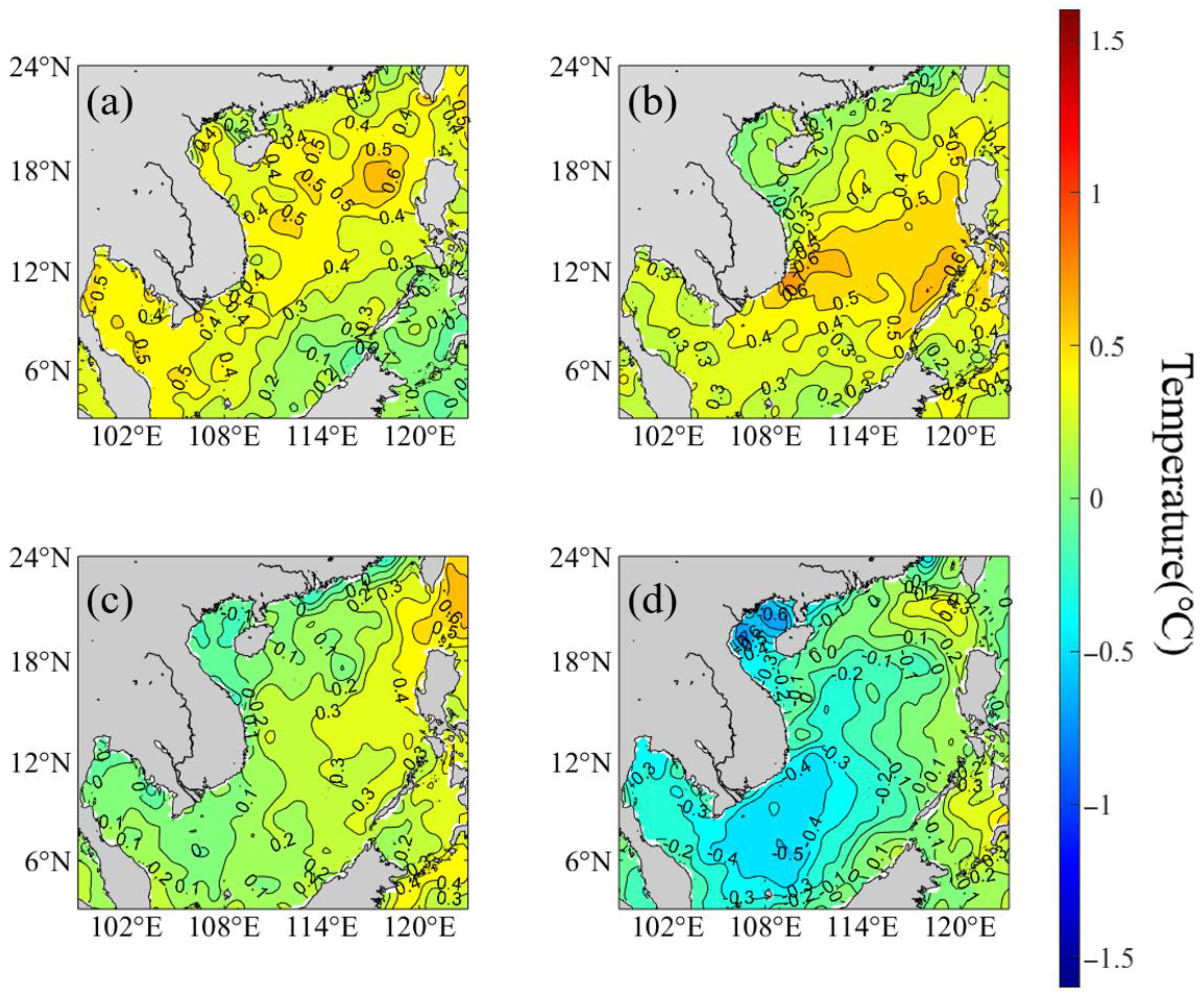

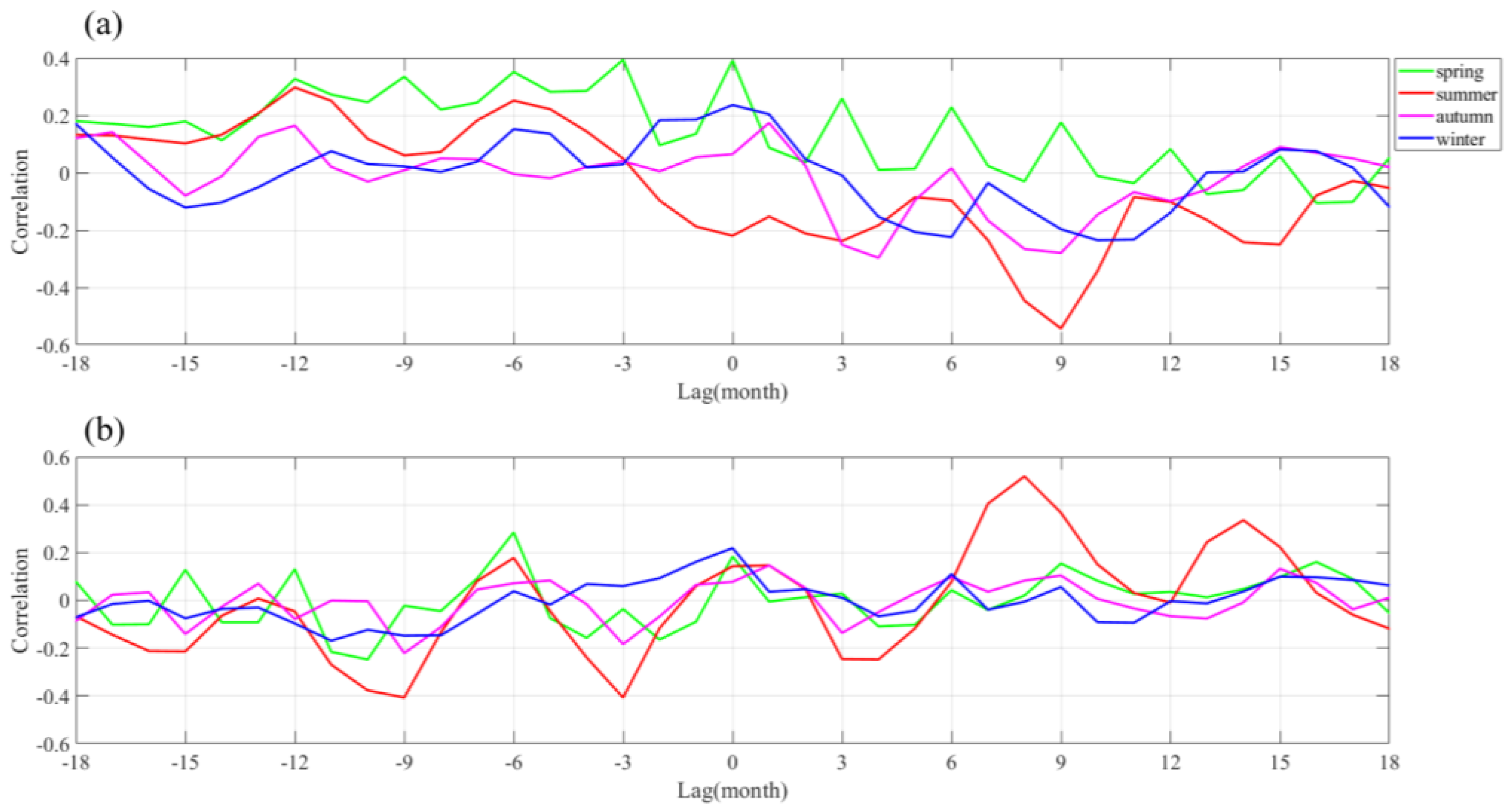
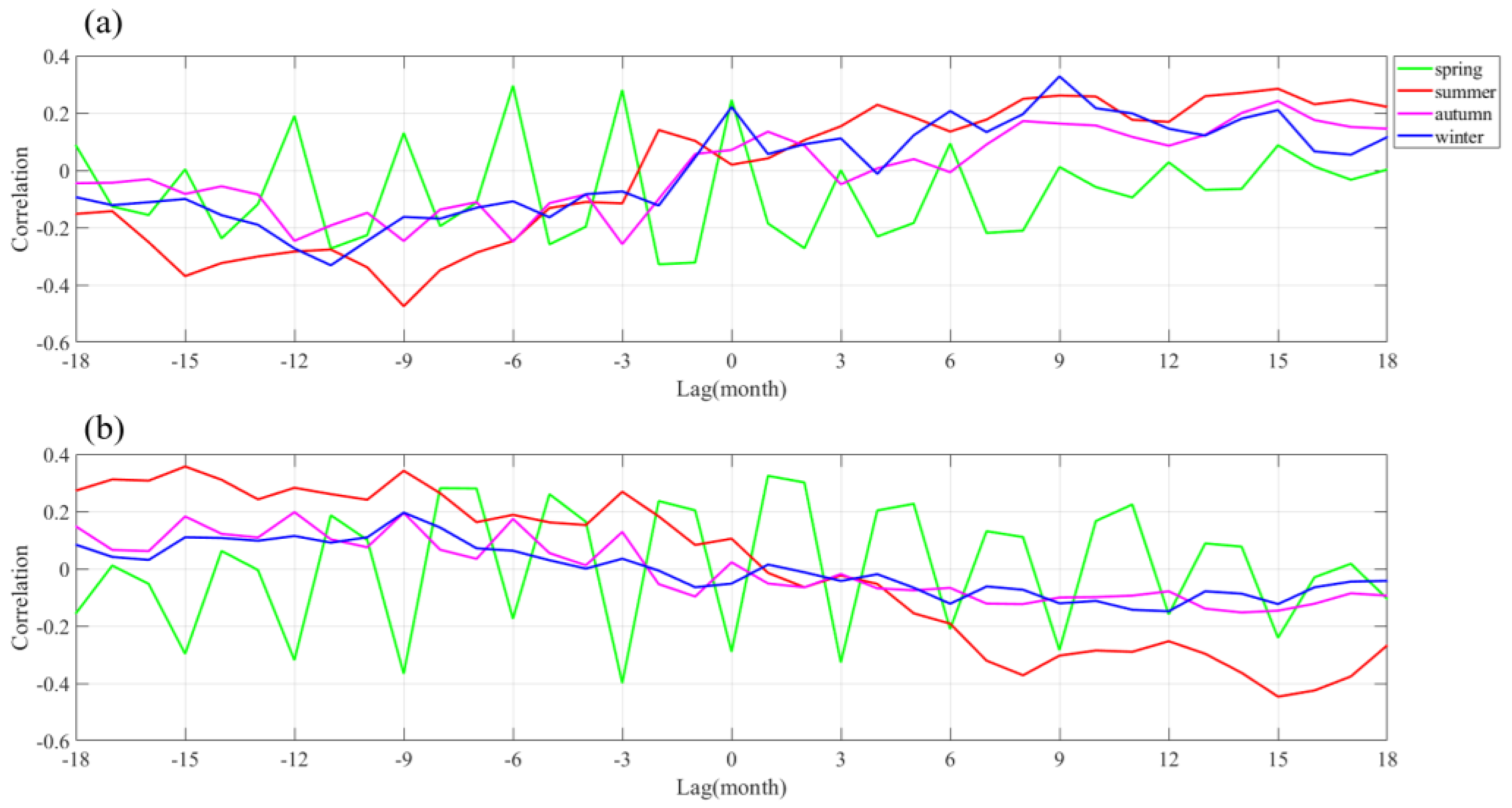
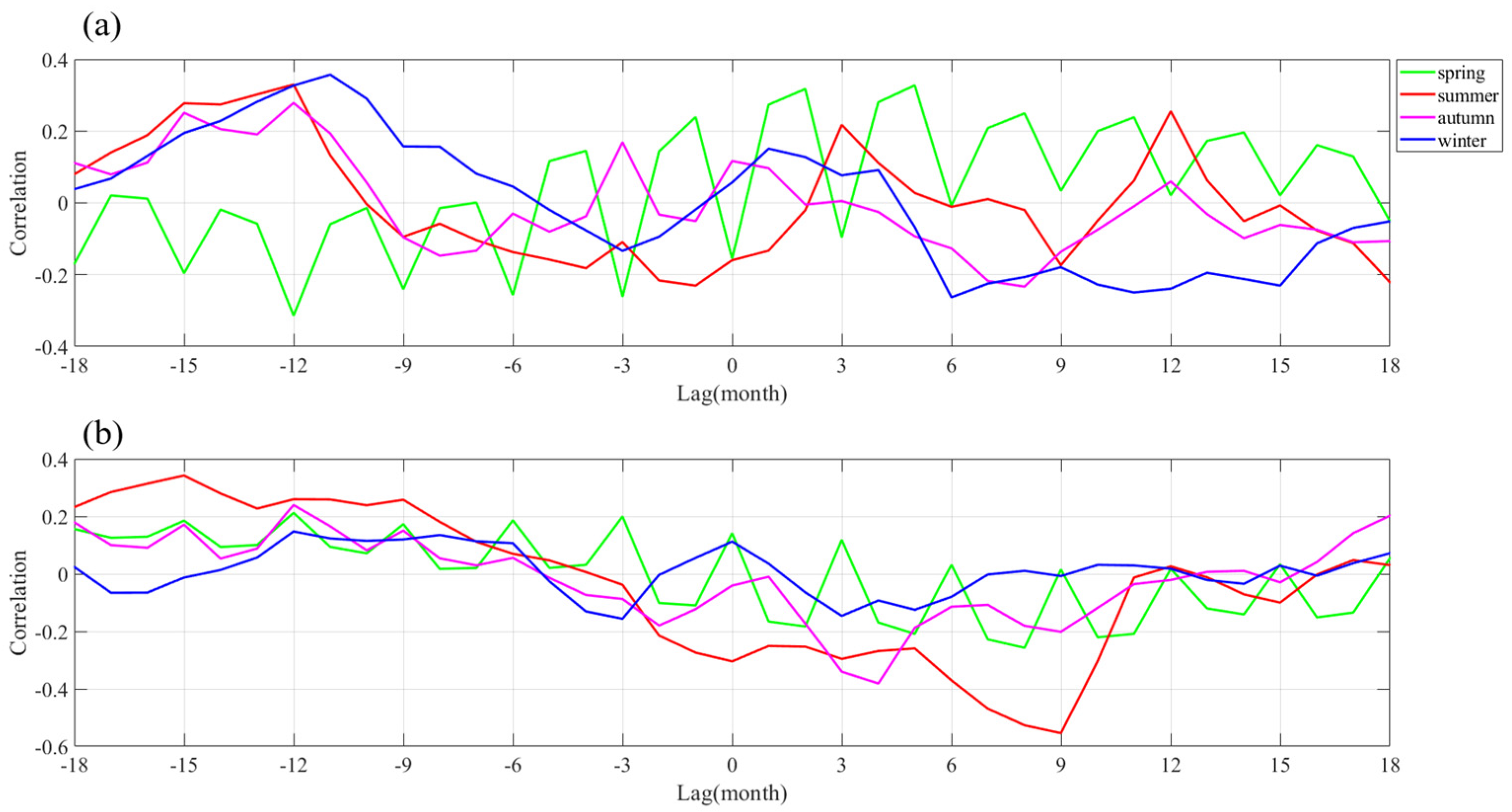
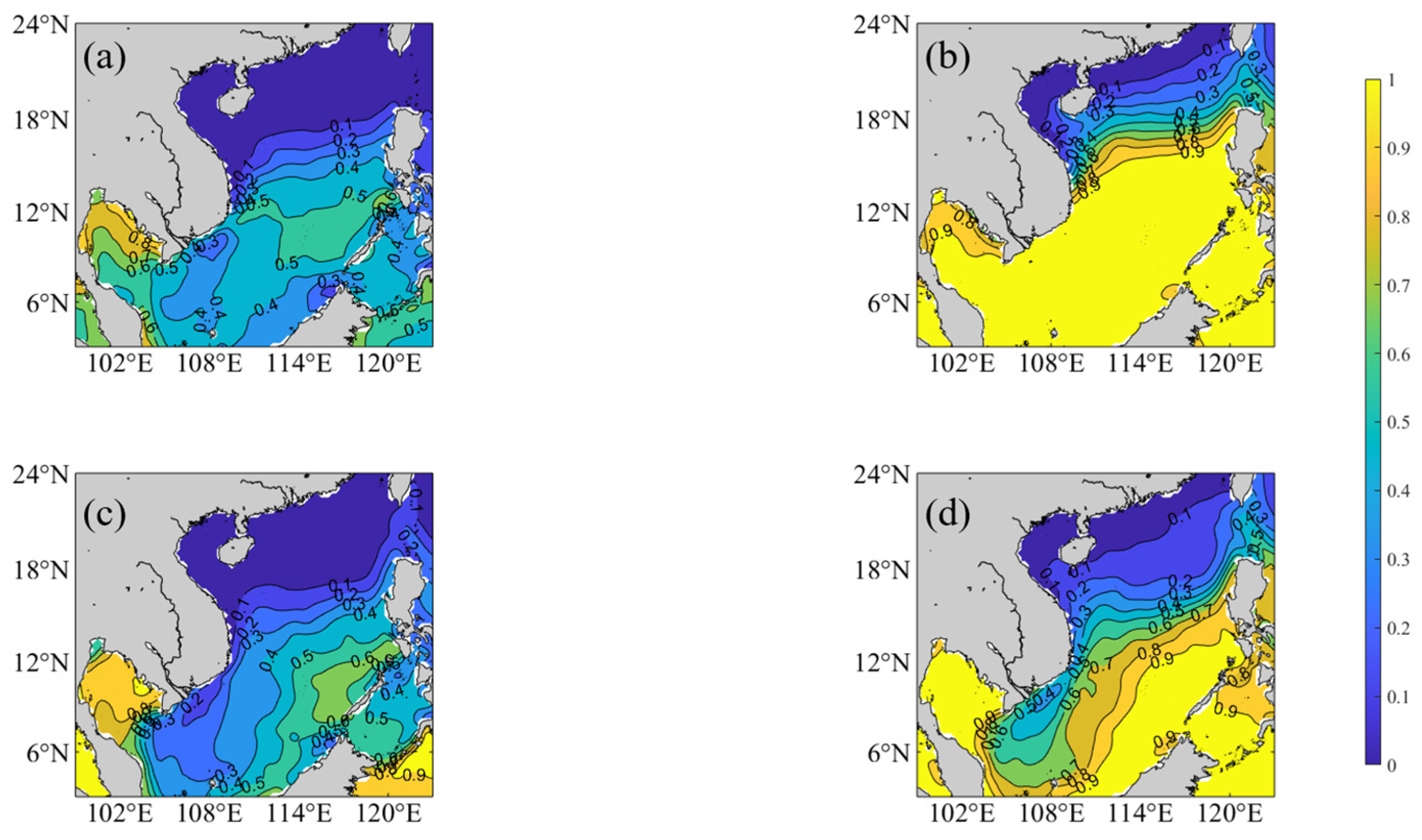
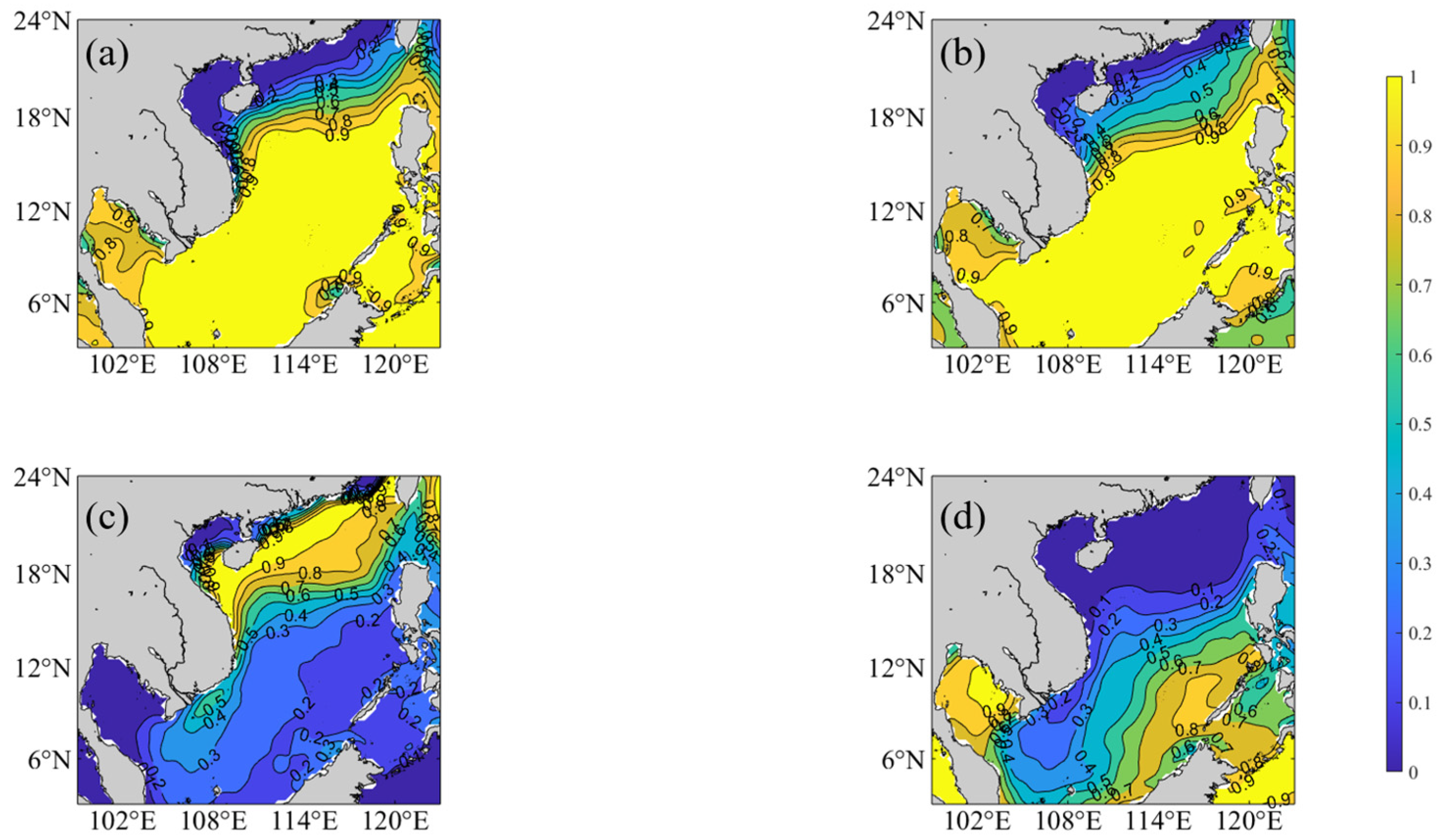
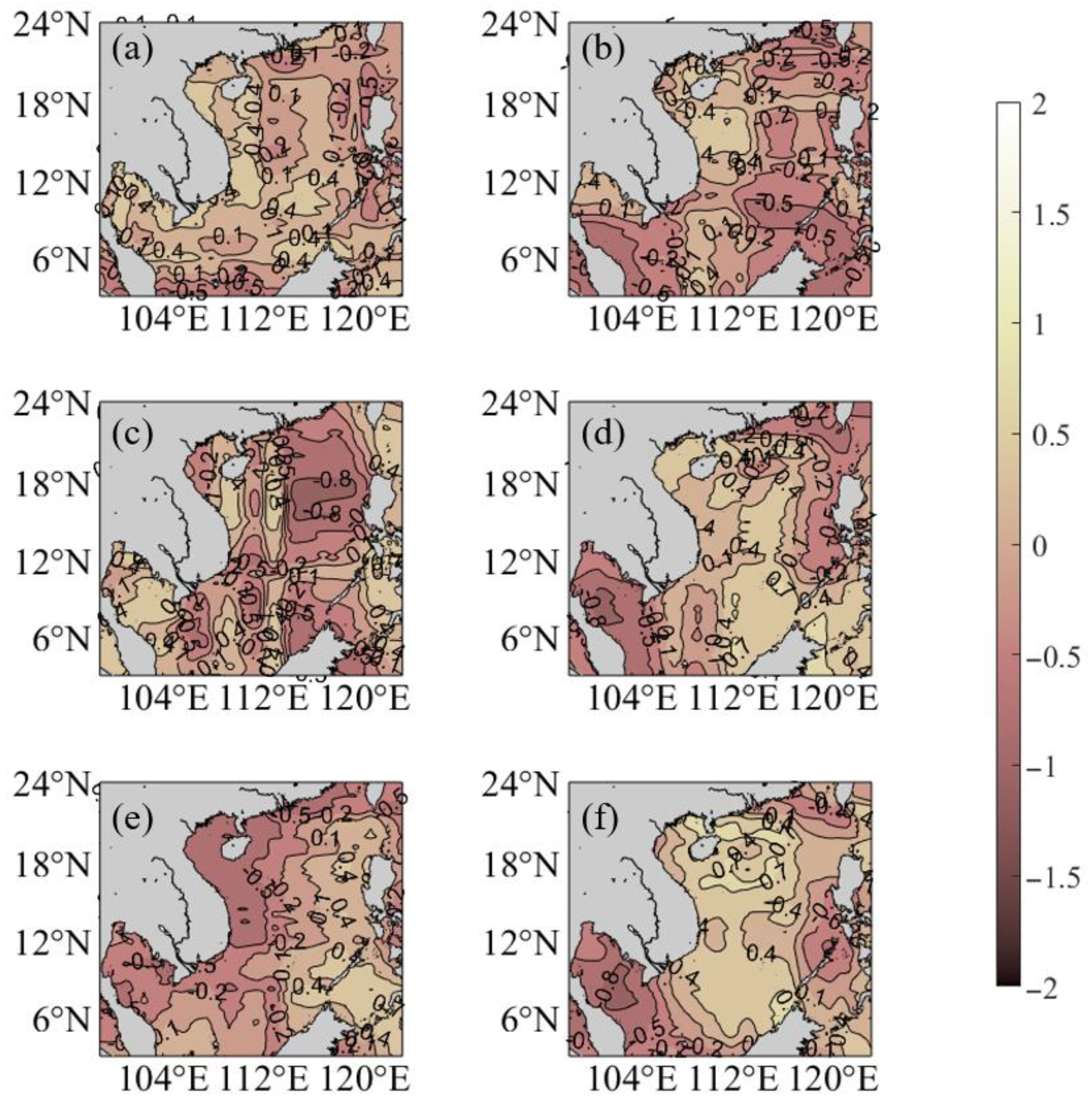

| El −1 | 1965 | 1971 | 1981 | 1985 | 1996 | 2008 | 2014 | 2022 | |
| El 0 | 1966 | 1972 | 1982 | 1986 | 1997 | 2009 | 2015 | 2023 | |
| El +1 | 1967 | 1973 | 1983 | 1987 | 1998 | 2010 | 2016 | 2024 | |
| La −1 | 1963 | 1969 | 1974 | 1987 | 1994 | 1997 | 2006 | 2009 | 2019 |
| La 0 | 1964 | 1970 | 1975 | 1988 | 1995 | 1998 | 2007 | 2010 | 2020 |
| La +1 | 1965 | 1971 | 1976 | 1989 | 1996 | 1999 | 2008 | 2010 | 2021 |
| Summer | Cloud | Evaproation | Net Heat Flux | Precipitation |
| El −1 | 0.36 | −0.06 | 0.11 | 0.22 |
| El 0 | 0.37 | 0.04 | 0.16 | 0.18 |
| El 1 | 0.05 | 0.03 | 0.05 | −0.02 |
| Winter | Cloud | Evaproation | Net Heat Flux | Precipitation |
| El −1 | −0.02 | −0.03 | −0.01 | −0.04 |
| El 0 | 0.08 | −0.16 | 0.05 | 0.09 |
| El 1 | 0.25 | −0.31 | −0.06 | 0.36 |
| Summer | Cloud | Evaproation | Net Heat Flux | Precipitation |
| La −1 | −0.02 | −0.1 | −0.06 | 0.05 |
| La 0 | 0.04 | 0.06 | −0.07 | −0.09 |
| La +1 | 0.16 | −0.13 | 0.14 | 0.12 |
| Winter | Cloud | Evaproation | Net Heat Flux | Precipitation |
| La −1 | −0.02 | 0.06 | −0.01 | −0.02 |
| La 0 | 0.47 | −0.36 | 0.36 | 0.37 |
| La +1 | −0.20 | 0.18 | −0.14 | 0 |
Disclaimer/Publisher’s Note: The statements, opinions and data contained in all publications are solely those of the individual author(s) and contributor(s) and not of MDPI and/or the editor(s). MDPI and/or the editor(s) disclaim responsibility for any injury to people or property resulting from any ideas, methods, instructions or products referred to in the content. |
© 2025 by the authors. Licensee MDPI, Basel, Switzerland. This article is an open access article distributed under the terms and conditions of the Creative Commons Attribution (CC BY) license (https://creativecommons.org/licenses/by/4.0/).
Share and Cite
Song, J.; Yao, L.; Guo, J.; Fu, Y.; Cai, Y.; Wang, M. The Seasonal Correlation Between El Niño and Southern Oscillation Events and Sea Surface Temperature Anomalies in the South China Sea from 1958 to 2024. J. Mar. Sci. Eng. 2025, 13, 153. https://doi.org/10.3390/jmse13010153
Song J, Yao L, Guo J, Fu Y, Cai Y, Wang M. The Seasonal Correlation Between El Niño and Southern Oscillation Events and Sea Surface Temperature Anomalies in the South China Sea from 1958 to 2024. Journal of Marine Science and Engineering. 2025; 13(1):153. https://doi.org/10.3390/jmse13010153
Chicago/Turabian StyleSong, Jun, Lingxiang Yao, Junru Guo, Yanzhao Fu, Yu Cai, and Meng Wang. 2025. "The Seasonal Correlation Between El Niño and Southern Oscillation Events and Sea Surface Temperature Anomalies in the South China Sea from 1958 to 2024" Journal of Marine Science and Engineering 13, no. 1: 153. https://doi.org/10.3390/jmse13010153
APA StyleSong, J., Yao, L., Guo, J., Fu, Y., Cai, Y., & Wang, M. (2025). The Seasonal Correlation Between El Niño and Southern Oscillation Events and Sea Surface Temperature Anomalies in the South China Sea from 1958 to 2024. Journal of Marine Science and Engineering, 13(1), 153. https://doi.org/10.3390/jmse13010153






